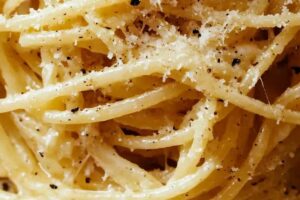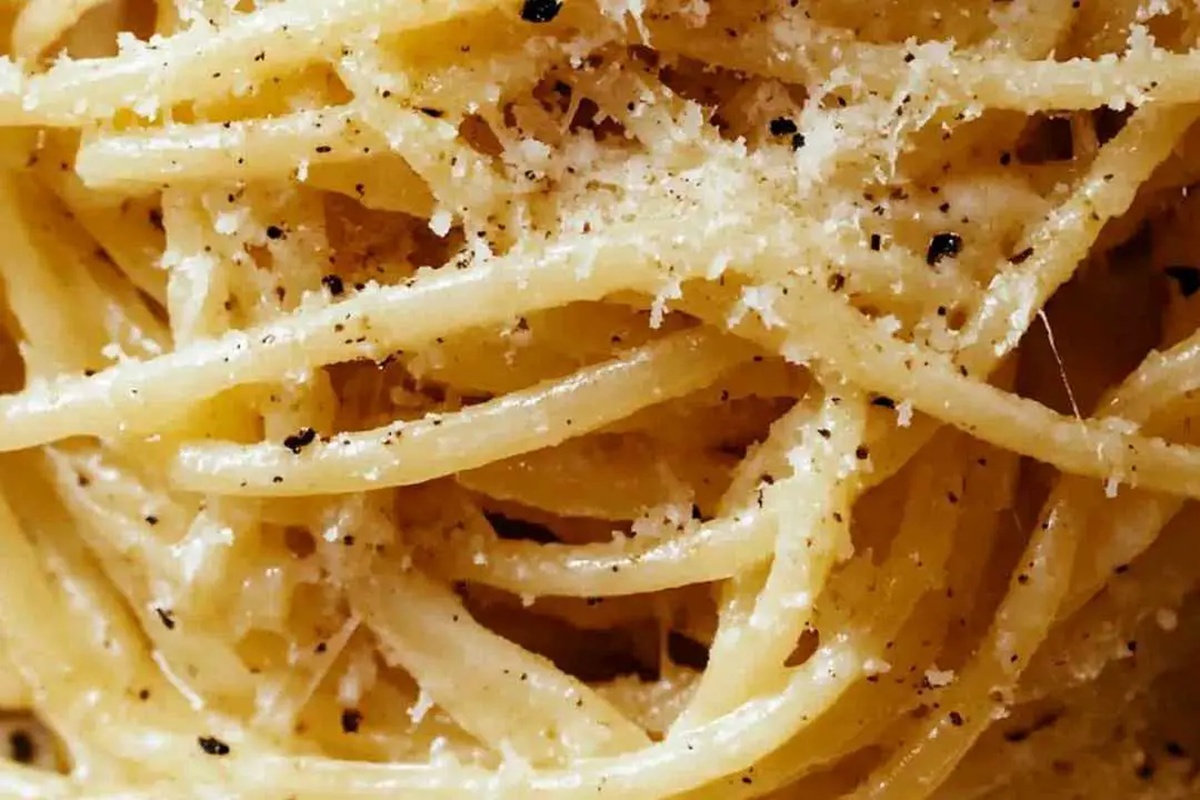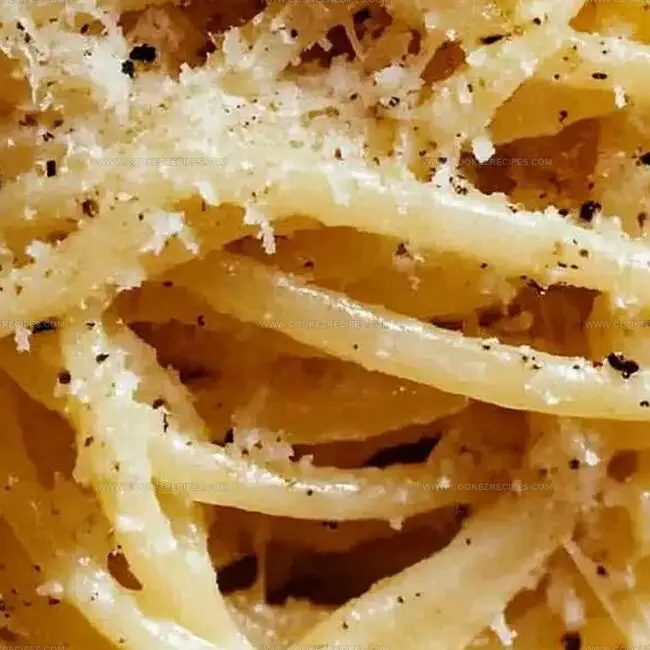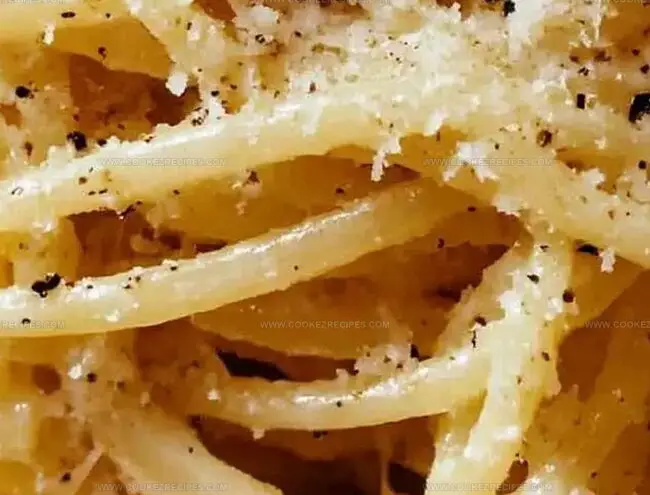Cacio e Pepe Pasta Recipe for Classic Weeknight Comfort
Mastering the perfect cacio e pepe demands skill and passion for Italian cuisine.
Pasta enthusiasts adore this minimalist Roman classic with its creamy, peppery charm.
Roman chefs have perfected this deceptively simple dish through generations of culinary expertise.
Pecorino romano cheese creates a luxurious backdrop for cracked black pepper’s sharp intensity.
Curious home cooks can easily replicate this restaurant-quality meal with just a few ingredients.
Technique matters more than complexity in crafting this beloved pasta preparation.
You’ll want to savor every bite of this authentic Mediterranean delicacy that celebrates simplicity’s true art.
Cacio e Pepe That Feels Like Roman Simplicity
Quick and Simple Weeknight Hero: Transforms basic ingredients into a restaurant-worthy dish in minutes.
Minimal Ingredient Magic: Requires only pasta, cheese, black pepper, and water – no complicated shopping list needed.
Technique-Building Recipe: Teaches essential pasta-making skills like water reservation and cheese emulsification that elevate home cooking.
Budget-Friendly Comfort: Delivers maximum flavor with minimal cost, using pantry staples most kitchens already have on hand.
Cacio e Pepe Pantry Picks
Pasta Ingredients:Cheese Ingredients:Seasoning Ingredients:Cacio e Pepe Simple Pasta Guide
Step 1: Boil Salty Water
Fill a large pot with water and add a generous pinch of salt.
Bring the water to a rolling boil over high heat.
Carefully add the pasta and cook until it’s just slightly undercooked, maintaining a firm bite in the center.
Step 2: Capture Pasta Liquid
Before draining, scoop out a cup of the starchy cooking water.
This liquid gold will be crucial for creating a silky sauce later.
Drain the pasta in a colander, shaking off excess water.
Step 3: Awaken Black Pepper
Place a wide skillet on medium heat.
Sprinkle whole or freshly ground black pepper into the dry pan.
Toast the pepper for about 30-45 seconds, moving it around to prevent burning.
You’ll know it’s ready when a rich, spicy aroma fills your kitchen.
Step 4: Bloom Pepper Essence
Pour a splash of reserved pasta water into the skillet.
Watch as the pepper sizzles and releases its intense flavor.
Swirl the liquid around to create a fragrant, peppery base for your sauce.
Step 5: Craft Cheese Magic
In a separate mixing bowl, gather your grated Pecorino Romano cheese.
Gradually introduce warm pasta water, stirring continuously.
Keep adding small amounts of water until you create a smooth, creamy cheese paste that clings together.
Step 6: Combine and Coat
Add the partially cooked pasta directly into the peppery skillet.
Pour the cheese mixture over the pasta.
Toss and stir vigorously, allowing the pasta to finish cooking and absorb the sauce.
If needed, splash in more pasta water to achieve a glossy, clinging consistency.
Step 7: Serve Immediately
Transfer the pasta to warm serving plates.
The sauce should coat each strand beautifully.
For an extra touch, sprinkle additional grated Pecorino Romano and freshly cracked black pepper on top.
Cacio e Pepe Cooking Tricks
Cacio e Pepe Storage Tips
Small Plates That Match Cacio e Pepe
Cacio E Pepe With Extra Cheese Choices
FAQs
The secret is to create a smooth cheese paste by gradually mixing Pecorino Romano with warm pasta water before adding it to the pan. This technique helps the cheese melt evenly and prevents clumping.
Toasting black pepper for about a minute releases its essential oils and deepens its flavor, creating a more intense and aromatic base for the sauce. The blooming process with pasta water further enhances the pepper’s rich taste.
Cook the pasta until just before al dente, as it will continue cooking when mixed with the hot sauce. Always reserve pasta water to help create a silky, emulsified sauce that coats the pasta perfectly.
While Pecorino Romano is traditional, it’s best to stick with this specific cheese for authentic flavor. Parmesan can work in a pinch, but it won’t provide the same sharp, salty taste that defines classic Cacio e Pepe.
Print
Cacio e Pepe Recipe
- Total Time: 20 minutes
- Yield: 4 1x
Description
Cacio e pepe whisks travelers straight to Roman kitchens with its simple elegance. Pecorino romano and black pepper dance together, creating pasta perfection that connects home cooks to centuries of Italian culinary tradition you’ll savor with each delicious bite.
Ingredients
Main Ingredients:
- 8 ounces (226 grams) pasta (tonnarelli, spaghetti, or bucatini)
- 1 cup (100 grams) finely grated pecorino romano
- 1 1/2 teaspoons (7.5 milliliters) freshly ground black pepper
Seasoning:
- Salt, to taste
Liquid:
- 1 cup (240 milliliters) reserved pasta water
Instructions
- Fill a spacious pot with water, season generously with salt, and bring to a rolling boil. Submerge pasta and cook until it reaches a tender yet firm consistency, moments before achieving perfect al dente texture.
- Carefully extract one cup of starchy cooking liquid, then drain pasta in a colander, allowing excess water to stream away.
- Select a broad skillet and warm it over moderate heat. Scatter cracked black peppercorns across the surface, gently roasting until their aromatic oils release and a rich, spicy fragrance fills the kitchen.
- Introduce a splash of reserved pasta water to the skillet, allowing the pepper to bloom and intensify its robust flavor profile.
- In a separate mixing vessel, combine finely grated Pecorino Romano with warm pasta water, whisking meticulously until a velvety, luxurious sauce emerges with a smooth, glossy consistency.
- Transfer the cooked pasta directly into the skillet with toasted pepper, tossing gently to coat each strand with the peppery essence.
- Gradually incorporate the creamy cheese mixture, stirring continuously to ensure even distribution and prevent clumping. If the sauce seems too thick, introduce additional pasta water to achieve a silky, clingy texture.
- Remove from heat and plate immediately, garnishing with an extra dusting of freshly ground black pepper and a delicate sprinkle of Pecorino Romano for enhanced depth of flavor.
Notes
- Always use freshly ground black pepper for the most intense, aromatic flavor that truly elevates the dish.
- Grate Pecorino Romano cheese by hand moments before using to ensure maximum melting potential and creamy texture.
- Work quickly when combining cheese and pasta water to prevent clumping and create a silky, emulsified sauce.
- For a gluten-free version, swap traditional pasta with alternative options like chickpea or rice pasta that hold sauce similarly.
- Prep Time: 5 minutes
- Cook Time: 15 minutes
- Category: Dinner
- Method: Boiling
- Cuisine: Italian
Nutrition
- Serving Size: 4
- Calories: 550
- Sugar: 0 g
- Sodium: 500 mg
- Fat: 20 g
- Saturated Fat: 10 g
- Unsaturated Fat: 8 g
- Trans Fat: 0 g
- Carbohydrates: 70 g
- Fiber: 3 g
- Protein: 20 g
- Cholesterol: 40 mg




Katherine Pierce
Recipe Curator & Food Educator
Expertise
Education
Boston University Metropolitan College
Certificate Program in the Culinary Arts
Focus: French and international cuisine techniques, Hands-on culinary training with industry professionals, Food industry insights and operations
Katherine grew up believing every dish has a story. She studied the art of food at Boston University and explored the history behind it. She loves pulling easy recipes from every corner of the world and putting them at your fingertips.
When Katherine’s not writing or testing new flavors, she’s teaching cooking classes, baking colorful mooncakes, or dreaming up new ways to mix old favorites with new twists.